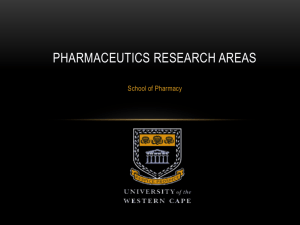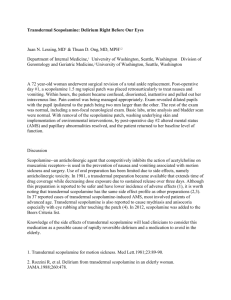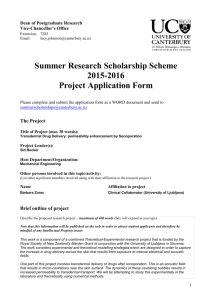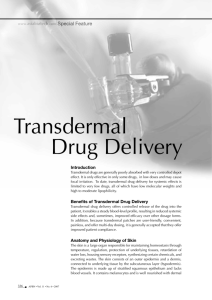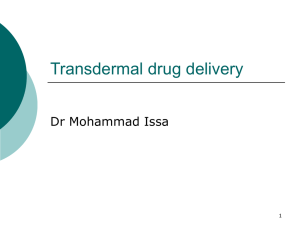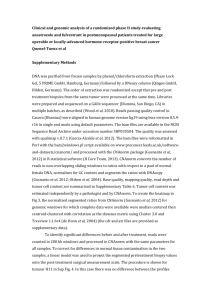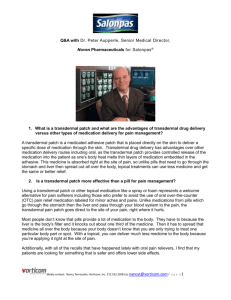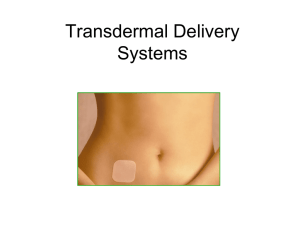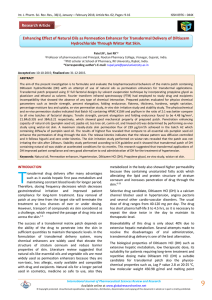Document 13308371
advertisement
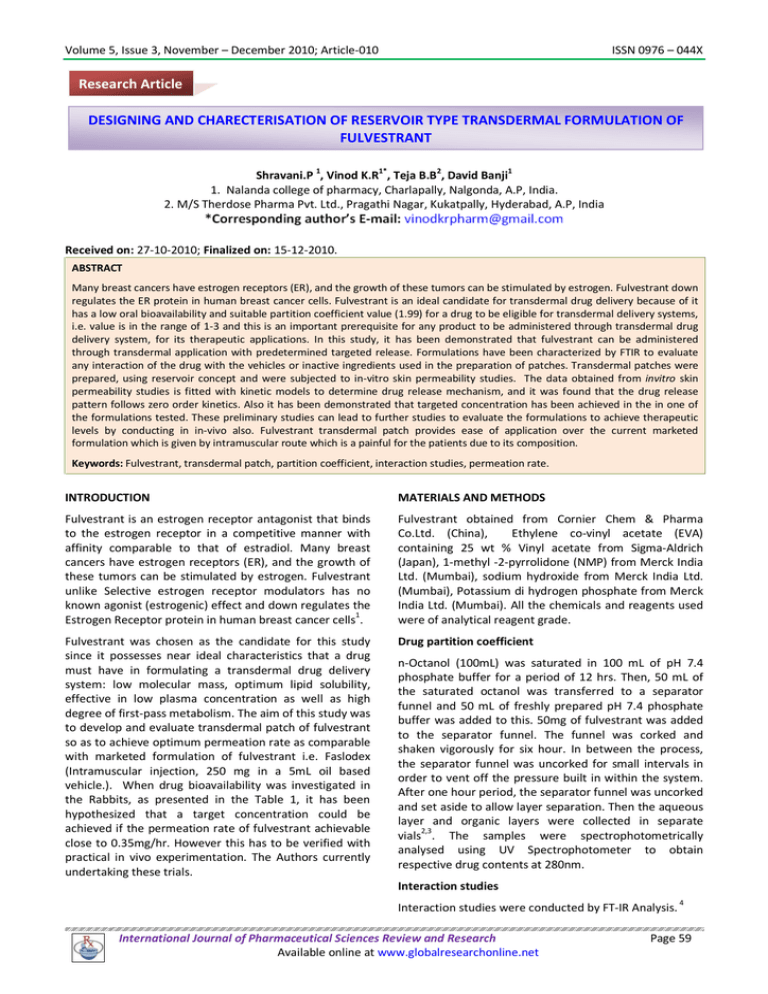
Volume 5, Issue 3, November – December 2010; Article-010 ISSN 0976 – 044X Research Article DESIGNING AND CHARECTERISATION OF RESERVOIR TYPE TRANSDERMAL FORMULATION OF FULVESTRANT Shravani.P 1, Vinod K.R1*, Teja B.B2, David Banji1 1. Nalanda college of pharmacy, Charlapally, Nalgonda, A.P, India. 2. M/S Therdose Pharma Pvt. Ltd., Pragathi Nagar, Kukatpally, Hyderabad, A.P, India Received on: 27-10-2010; Finalized on: 15-12-2010. ABSTRACT Many breast cancers have estrogen receptors (ER), and the growth of these tumors can be stimulated by estrogen. Fulvestrant down regulates the ER protein in human breast cancer cells. Fulvestrant is an ideal candidate for transdermal drug delivery because of it has a low oral bioavailability and suitable partition coefficient value (1.99) for a drug to be eligible for transdermal delivery systems, i.e. value is in the range of 1-3 and this is an important prerequisite for any product to be administered through transdermal drug delivery system, for its therapeutic applications. In this study, it has been demonstrated that fulvestrant can be administered through transdermal application with predetermined targeted release. Formulations have been characterized by FTIR to evaluate any interaction of the drug with the vehicles or inactive ingredients used in the preparation of patches. Transdermal patches were prepared, using reservoir concept and were subjected to in-vitro skin permeability studies. The data obtained from invitro skin permeability studies is fitted with kinetic models to determine drug release mechanism, and it was found that the drug release pattern follows zero order kinetics. Also it has been demonstrated that targeted concentration has been achieved in the in one of the formulations tested. These preliminary studies can lead to further studies to evaluate the formulations to achieve therapeutic levels by conducting in in-vivo also. Fulvestrant transdermal patch provides ease of application over the current marketed formulation which is given by intramuscular route which is a painful for the patients due to its composition. Keywords: Fulvestrant, transdermal patch, partition coefficient, interaction studies, permeation rate. INTRODUCTION MATERIALS AND METHODS Fulvestrant is an estrogen receptor antagonist that binds to the estrogen receptor in a competitive manner with affinity comparable to that of estradiol. Many breast cancers have estrogen receptors (ER), and the growth of these tumors can be stimulated by estrogen. Fulvestrant unlike Selective estrogen receptor modulators has no known agonist (estrogenic) effect and down regulates the Estrogen Receptor protein in human breast cancer cells1. Fulvestrant obtained from Cornier Chem & Pharma Co.Ltd. (China), Ethylene co-vinyl acetate (EVA) containing 25 wt % Vinyl acetate from Sigma-Aldrich (Japan), 1-methyl -2-pyrrolidone (NMP) from Merck India Ltd. (Mumbai), sodium hydroxide from Merck India Ltd. (Mumbai), Potassium di hydrogen phosphate from Merck India Ltd. (Mumbai). All the chemicals and reagents used were of analytical reagent grade. Fulvestrant was chosen as the candidate for this study since it possesses near ideal characteristics that a drug must have in formulating a transdermal drug delivery system: low molecular mass, optimum lipid solubility, effective in low plasma concentration as well as high degree of first-pass metabolism. The aim of this study was to develop and evaluate transdermal patch of fulvestrant so as to achieve optimum permeation rate as comparable with marketed formulation of fulvestrant i.e. Faslodex (Intramuscular injection, 250 mg in a 5mL oil based vehicle.). When drug bioavailability was investigated in the Rabbits, as presented in the Table 1, it has been hypothesized that a target concentration could be achieved if the permeation rate of fulvestrant achievable close to 0.35mg/hr. However this has to be verified with practical in vivo experimentation. The Authors currently undertaking these trials. Drug partition coefficient n-Octanol (100mL) was saturated in 100 mL of pH 7.4 phosphate buffer for a period of 12 hrs. Then, 50 mL of the saturated octanol was transferred to a separator funnel and 50 mL of freshly prepared pH 7.4 phosphate buffer was added to this. 50mg of fulvestrant was added to the separator funnel. The funnel was corked and shaken vigorously for six hour. In between the process, the separator funnel was uncorked for small intervals in order to vent off the pressure built in within the system. After one hour period, the separator funnel was uncorked and set aside to allow layer separation. Then the aqueous layer and organic layers were collected in separate 2,3 vials . The samples were spectrophotometrically analysed using UV Spectrophotometer to obtain respective drug contents at 280nm. Interaction studies Interaction studies were conducted by FT-IR Analysis. 4 International Journal of Pharmaceutical Sciences Review and Research Available online at www.globalresearchonline.net Page 59 Volume 5, Issue 3, November – December 2010; Article-010 ISSN 0976 – 044X IR Analysis: The IR absorption spectra of the pure drug i.e. fulvestrant (Fig 1), polymer i.e. EVA (Fig 2) drug and polymer (Fig 3), also optimized formulation (Fig 4) were -1 taken in the range of 400-4000cm . the solutions were heated at 50-55°C for 10 minutes. Then 10 mL of this solution was slowly transferred into the square glass mould and left for 7 hrs for evaporation of solvent in order to obtain a thin film. Preparation of drug release rate controlling membrane Preparation of Fulvestrant drug reservoir and of transdermal patch: EVA copolymer membrane was prepared by Solvent evaporation method. The authors have referenced an article published by Ramesh Panchanghnula et cal 2002, which is one of the articles published about the application of this polymer in transdermal membrane preparations.5 Required amount of EVA was weighed and transferred to 100 mL beakers. Then 50mL of chloroform was added to each beaker to give solutions of concentration 3%, 6%, 9%, 12%. These solutions were kept aside overnight, to allow the polymer to swell. Later Formulation F1 F2 F3 F4 In 0.4mL of NMP, 100mg of fulvestrant is added and properly mixed to give a uniform drug reservoir. In the pouch prepared with EVA membrane, drug solution is poured, and then the pouch is sealed on fourth side at 150°C for 4–8 seconds by a heat sealing device corresponding to a 4 cm2 surface area. 4% polyvinyl 2 alcohol was used as backing layer. Reservoir patches were coated with adhesive layer and patches were protected using a protective release liner (wax paper) 6. Table 1: Composition of transdermal patch Solvent system Amount of FST Rate controlling membrane NMP 100mg 3% EVA NMP 100mg 6% EVA NMP 100mg 9% EVA NMP 100mg 12% EVA Ex vivo skin permeability studies RESULTS AND DISCUSSION Franz diffusion cell was used for these permeation studies, properly thawed porcine skin was mounted between the compartments of the Franz diffusion cell with the stratum corneum side facing the donor compartment and the dermal side facing the receptor compartment. The volume of the Franz diffusion cells is 12mL7. The patch to be tested was placed on the skin i.e. in donor compartment. Phosphate buffer solution of pH 7.4 (12 mL) (37°C ± 1°C) was used as receptor phase and the entire assembly was kept on a magnetic stirrer with continuous stirring of the solution in the receiver compartment8. Samples were withdrawn at regular periods through the sampling port and replaced by an equal volume of fresh buffer solution maintained at 37°C. The samples were filtered through a 0.2µm filter membrane, absorbance of sample was measured spectrophotometrically at 280nm against blank (phosphate buffer solution of pH 7.4). The amount of drug permeated was plotted against time. Transdermal patch of fulvestrant was formulated based on reservoir type design. n-octanol and in vitro study fluid (here phosphate buffer, pH7.4) are considered to the standard system for determining the drug partition coefficient between skin and in vitro fluid10 (carvedilol). The logarithmic value of the partition coefficient was found to be 1.99±0.02. The results obtained indicate that the drug possesses sufficient lipophilicity, which meets the requirements of formulating it into transdermal patch. Curve fitting analysis To examine the drug permeation kinetics and mechanism, drug release data were fitted to kinetic models such as zero-order, first-order, Higuchi, Peppa’s. Qt versus t (zero order), log Qt versus t (first order), Qt versus square root of t (Higuchi), log Qt versus log t (Peppas), where Qt is the amount of drug released at time t. The criteria for selecting the most appropriate model are highest R2 value as it indicates the linearity of data9. Interaction studies were carried out to ascertain any interaction of the drug with the excipient used in the preparation of Transdermal Drug Delivery Systems. From the IR spectra (Fig 1,Fig 2, Fig 3, Fig 4) it was observed that there were no changes in these main peaks in IR spectra of pure drug, drug and polymer, medicated formulation, which show there were no physical interactions due to some bond formation between drug, solvent and polymer. Since there are no interactions between drug (FST), solvent (NMP) and polymer (EVA), the patches were evaluated for ex vivo skin permeability studies. In vivo studies were conducted on the Rabbits over 28 days period and evaluated the plasma samples from the blood, collected at periodic intervals, by using a LCMC method developed by one of the authors of this article in coordination with a CRO (Dharmesh & Bulusu Teja etal, 2009). The results of this study are presented in the Table No: 2 and figure 5. It was hypothesized that a release concentration of drug from the reservoir to the dissolution medium should be International Journal of Pharmaceutical Sciences Review and Research Available online at www.globalresearchonline.net Page 60 Volume 5, Issue 3, November – December 2010; Article-010 around 0.35 mg/hr. Formulation F3 has a Permeation rate of 0.33mg/h, which is very close to required permeation rate, permeation from F3 is through dead skin therefore permeation can be little high in live tissue. From this discussion formulation F3 is considered as optimized formulation, which can be considered for further studies. To know the mechanism of drug release from these formulations, the data were treated according to zero order, First-order, Higuchi’s and Peppas pattern. The release kinetics of the transdermal patches followed zero ISSN 0976 – 044X order (0.991 – 0.999) and Higuchi’s diffusion kinetics (0.907 – 0.921). According to the first order the re-lease of drug is based on the concentration of the drug in the formulation. Further as per Higuchi’s release kinetics; the drug release followed diffusion mechanism. Amount of drug released when plotted against time, the plots showed high linearity. It indicated that release pattern followed zero order kinetics. Figure 1: IR Spectra of pure drug Figure 2: IR Spectra of polymer (EVA) Figure 3: IR Spectra of drug & polymer International Journal of Pharmaceutical Sciences Review and Research Available online at www.globalresearchonline.net Page 61 Volume 5, Issue 3, November – December 2010; Article-010 ISSN 0976 – 044X Figure 4: IR Spectra of optimized formulation Table 2: Evaluation of patches Parameters 2 Permeation rate (mg/4 cm .h) 2 Zero order (R ) First order (R2) Higuchi (R2) Peppas (R2) F1 0.7 0.998 0.924 0.910 0.980 F2 0.48 0.991 0.833 0.907 0.882 F3 0.33 0.999 0.730 0.921 0.788 F4 0.18 0.998 0.464 0.913 0.499 Figure 5: Ex Vivo skin permeation profiles of Fulvestrant TDDS formulations 6 5 4 F1 F2 F3 Qt 3 2 1 0 0 2 4 6 t (hrs) 8 10 CONCLUSION REFERENCES Authors finally conclude that a further investigation into the formulation and evaluation of the products in vivo models is required, and with the available data it is quite possible to manufacture a transdermal patch to replace the very painful IM injections. Also the desired levels of the drug in the blood can be enhanced basing on the requirement. 1. Morris.C, Wakeling. A, Fulvestrant (Faslodex)- a new treatment option for patients progressing on prior endocrine therapy, Endocrine-Related Cancer, Volume 9, 2002, 267-276. 2. Yuveraj singh tanwar, Chetan Singh Chauhan, Anshu Sharma, Development and evaluation of Carvedilol transdermal patch, Acta Pharm., Volume 57, 2007, 151-159. 3. Leo. A, Hansch. C, Elkins. D, Partition coefficients and their uses, Chem Rev., Volume 71(6), 1971, 525–616. Acknowledgment: Authors wish to express their thanks and gratitude to Nalanda College of Pharmacy for utilizing the library facilities and Therdose Pharma Pvt. Ltd. were the present project was done. International Journal of Pharmaceutical Sciences Review and Research Available online at www.globalresearchonline.net Page 62 Volume 5, Issue 3, November – December 2010; Article-010 4. Mohamed aqil, Yasmin sultana, Asgar ali, Matrix type transdermal drug delivery systems of metoprolol tartrate: In vitro characterization, Acta Pharm., Volume 53, 2003, 119–125. 5. Ramesh Panchagnula, Sateesh Kandavili, Vinod Nair, Polymers in Transdermal Drug Delivery Systems, Pharmaceutical Technology, 2002, 62-80. 6. 7. Amir mehdizadeh,Tayebe toliate, Mohammad reza rouini, Sharyar abashzadeh, Farid dorkoosh, Design and in vitro evaluation of new drug-in-adhesive formulations of fentanyl transdermal patches, Acta Pharm., Volume 54, 2004, 301–317. Parikh D.K, Ghosh T.K, Feasibility of Transdermal Delivery of Fluoxetine, AAPS PharmSciTech., Volume 6(2), 2005, E144-E149. ISSN 0976 – 044X 8. Ashish Jain, Bijaya Ghosh, Satish Nayak, Vandana Soni, A Study of Transdermal Drug Delivery of Glibenclamide Using Iontophoresis, International Journal of Health Reasearch, Volume 2(1), 2009, 8391, (2009). 9. Thakkar V.T, Shah P.A, Soni T.G, Parmar M.Y, Gohel M.C, Gandhi T.R, Goodness-of-Fit: ModelDependent approach for release kinetics of levofloxacin hemi-hydrates floating tablet, Dissolution technology, Volume 1, 2009, 35-9. 10. Singh U.V, Pandey.S, Udupa.N, Preparation and evaluation of flubiprofen and diclofenac sodium transdermal films, Indian Journal of Pharmaceutical Sciences, Volume 54, 1993, 145-147. About Corresponding Author: Mr. Vinod K.R Mr. Vinod K.R., took his PG Pharmaceutics from the Tamilnadu, Dr. MGR Medical University, Chennai in the year 1999, has guided more than twelve projects in NDDS and has more than thirty scientific publications. His affiliated qualifications include PGDMM, NTTP etc. also is a reviewer of selected journals. International Journal of Pharmaceutical Sciences Review and Research Available online at www.globalresearchonline.net Page 63
